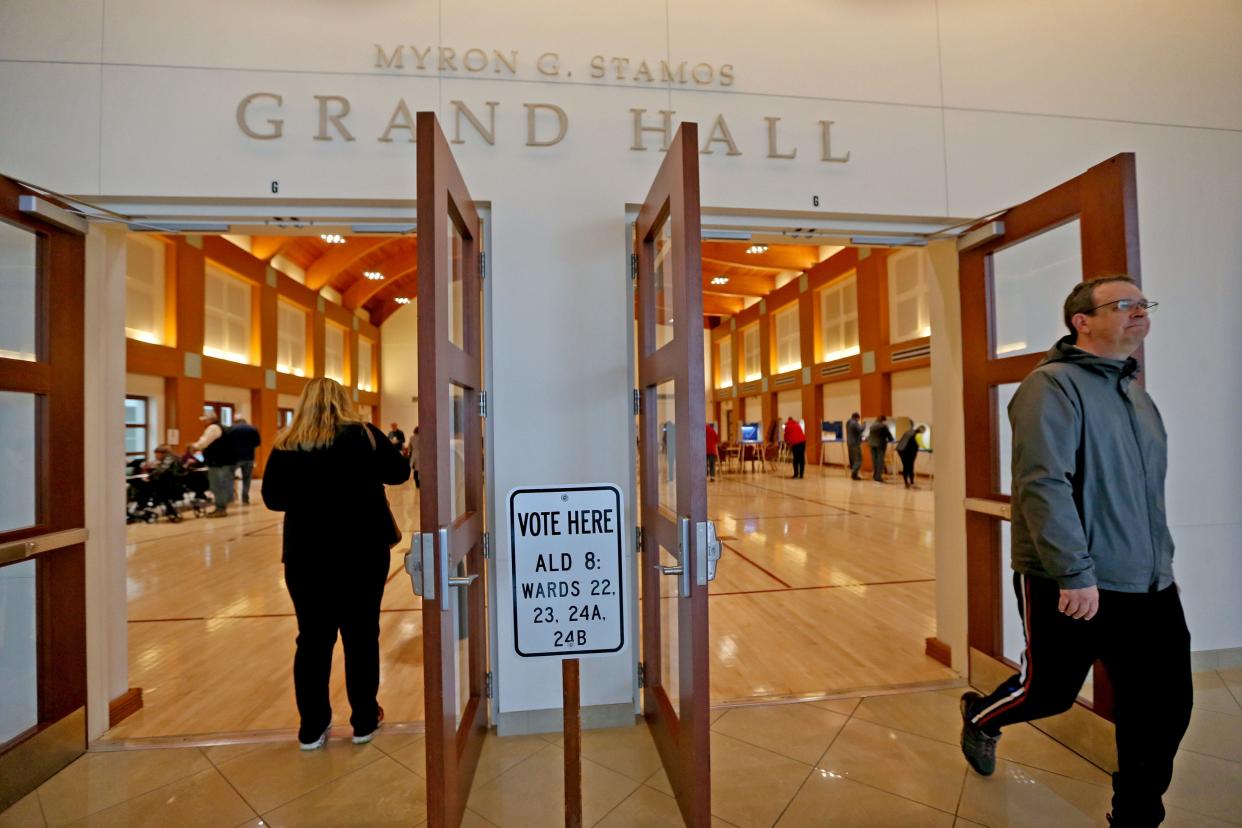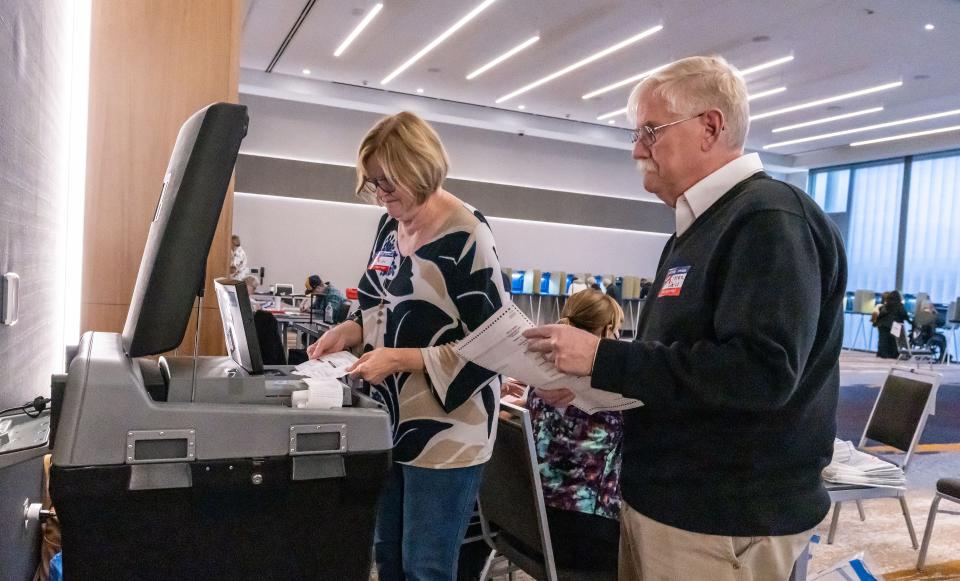Gilbert: What 30 years of voting history tells us about Wisconsin's shifting suburban vote

As the gap between urban and rural America widens, the most contested turf in swing-state elections can be found in the suburbs.
Consider Wisconsin, where the outcome of next year’s presidential race may hinge on whether Republicans can stem eight years of suburban decline at the polls.
The fight for Wisconsin’s suburbs is often told through the Republican-leaning “WOW Counties” outside Milwaukee (Waukesha, Ozaukee and Washington).
But the story is much bigger than that.

The suburban battlefield in this state stretches from Milwaukee to Madison to Green Bay to the western Wisconsin exurbs of Minnesota’s Twin Cities.
Most of these communities have been trending in a Democratic direction in the Trump Era.
But the suburbs of swing-state Wisconsin continue to differ wildly in the way they vote, reflecting differences in income, race, education and political culture.
What does this landscape look like today?
How much has it changed in recent decades?
And how are suburban voting trends affecting big elections in Wisconsin?
To answer these questions, I examined the 30-year voting history of eight clusters of suburban communities in the state: five in metropolitan Milwaukee, one outside Madison, one in the Green Bay-Appleton metro, and one on the Wisconsin border of Minnesota.
There is more than one way to map the suburban vote. (There is more than one way to define “suburban.”) I used these areas because they reflect the political diversity of the suburban vote, they illustrate how that vote is changing, they show the power of that vote, and they are home to the vast majority of the state’s suburban voters.
Some broad takeaways:
The 'suburban vote' in Wisconsin spans the entire partisan spectrum
Polls show that suburban voters collectively are more evenly divided than urban voters on the left and rural voters on the right. But the suburban electorate includes a lot of very one-sided places on both sides. The left pole of suburban Wisconsin is occupied by the Madison suburbs and northern Milwaukee County.
Both these areas voted Democratic for governor last year by more than 40 points. The right pole is occupied by the most conservative county in the outer Milwaukee suburbs, Washington, which voted Republican for governor by 38 points. That is an 80-point voting gap between liberal and conservative suburbia.
In between those poles is a collection of far more “purple” places: the suburbs outside Green Bay and Appleton, the suburbs on the south side of Milwaukee County, and the exurbs on the periphery of Minnesota’s Twin Cities in western Wisconsin.
The state’s metropolitan suburbs have taken very different paths over the past 30 years
Some have grown ever more one-sided. The Madison suburbs have gone from about 10 points bluer than the rest of the state to 40 points bluer. Washington County has gone from about 25 points redder than the state as a whole to about 40 points redder.
Some areas, like the suburbs of Green Bay and Appleton, haven’t changed dramatically in partisan terms in recent decades. But others have undergone something more like a transformation. Milwaukee’s North Shore leaned Republican in the 1990s.

Now it rivals the Madison suburbs for its extreme Democratic margins. In the 1990s, Ozaukee was the most Republican of Wisconsin’s 72 counties. Based on last year’s results for governor, it is now the 44th most Republican county.
Despite their differences, most of these suburban areas have moved in the same direction since the 2014 election — away from the Republican Party
The shift has been very small in some places and very big in others. Ozaukee gave Republicans a 41-point margin in the 2014 governor’s race. That shrank to 11 points in 2022. The suburbs of northern Milwaukee County voted Republican for president by 3 points in 2000. They voted Democratic for president by 42 points in 2020.
Red, purple or blue, these suburbs will be at the epicenter of the 2024 election here.
One reason, of course, is that they’re home to a lot of people. In polling by the Marquette Law School, about 30% of Wisconsin voters live in the “core suburbs,” a category based on the government’s Rural-Urban Commuting Area Codes. Not coincidentally, the eight geographic areas I examined for this analysis represent just under 30% of the statewide vote.
Another reason is that these suburbs include some of the most fluid places on the election map, and those changes are having a profound impact on Wisconsin elections.
Take Democrat Tony Evers’ victory over incumbent Republican Gov. Scott Walker in 2018. There was a swing of more than 80,000 votes against Walker between the 2014 and 2018 elections in the eight suburban areas described below. Walker lost statewide by less than 30,000 votes.
Take Democrat Joe Biden’s victory over incumbent Republican President Donald Trump in Wisconsin in 2020.There was a nearly 50,000-vote swing against Trump from 2016 to 2020 in these eight areas. Trump lost statewide by about 20,000 votes.
Where did the biggest suburban swings occur?
In the race for governor, about a third of the Democrats’ suburban gains between 2014 and 2018 came from the WOW counties. Just under a third came from the inner suburbs of Milwaukee County. And more than a quarter came from the Madison suburbs.
In the race for president, almost 40% of the Democrats’ suburban gains from 2016 to 2020 came from the communities outside Madison, more than a third came from the inner suburbs of Milwaukee County, and less than a fifth came from Waukesha, Ozaukee and Washington counties.
The vaunted WOW Counties are fragmenting
Which brings us back to the politically iconic WOW Counties, which have taken on such a starring role in the story of Wisconsin elections that they inspired a 2016 cartoon in the New Yorker magazine. It showed Russian officials looking up at a US election map. Their briefer tells them (in Russian): “Ultimately, it all comes down to Waukesha County.”
"Ultimately, it all comes down to Waukesha County." A cartoon by Paul Noth, from 2016. pic.twitter.com/MrjubqHeUH
— The New Yorker (@NewYorker) February 16, 2018
There was some truth in that joke. Waukesha and the other WOW counties have been hugely consequential in statewide elections. Their penchant for turning out in droves and voting Republican by landslide margins helped Walker win decisive elections for governor in 2010, 2012 and 2014 and helped George W. Bush come extremely close to winning the state for president in 2000 and 2004. Today, their increasing competitiveness is making it harder for Republicans to win statewide.
At the same time, the mystique of the WOW Counties can obscure some important points. One is that the “WOW counties” are fragmenting politically. They used to vote in concert. But they began to separate a little in the 2000s, and that trend has intensified since 2014. The GOP’s margins in big elections are now almost 30 points larger in Washington than in Ozaukee. One county remains deep red and the other is on its way to being quite purple, raising the question of how useful it is to talk about the “WOW County vote.”
A second point is that there is a lot more to the “shifting suburbs” story than the WOW counties. The evolution of the Madison suburbs doesn’t get quite as much attention. But the gains Democrats made in the suburbs of Dane County had a bigger impact on Biden’s victory over Trump in 2020 than the GOP’s decline in the WOW counties. So did the shift toward Democrats in the suburbs within Milwaukee County.
Tracing the reddest and bluest turf in Wisconsin's suburbs
To explore the suburban landscape a little further, here are the eight places I looked at for this analysis, starting with the reddest turf and moving to the bluest. The number in parentheses next to each area is the number of votes it cast for president in 2020, which gives you a sense of its relative voting power (There were about 3.3 million votes cast statewide):
Washington County (88,070 votes in 2020): This is the reddest of the three “WOW” counties and the most conservative county of any size in Wisconsin. It’s also the most blue-collar of the WOW Counties. At a time when college-educated voters have shifted away from the GOP, this helps explain why Republican margins have held up better here than in Waukesha or Ozaukee. Bush carried Washington County by 38 points in 2000. Trump won it by 38 points in 2020. And Republican Tim Michels carried it by 38 points for governor last year.
Waukesha (267,996 votes): Its size makes Waukesha the most important Republican county in Wisconsin. It’s also an area of deep concern for Republicans since it’s not packing the electoral punch it used to for the party. Republican margins for governor have declined from 46 points in 2014 to 34 in 2018 to 20 in 2022. The party’s presidential margins have dropped from 35 in 2012 to 27 in 2016 to 21 in 2020. Something similar has happened in U.S. Senate races and even nonpartisan contests for the state Supreme Court. The biggest changes are in the more densely populated suburbs close to Milwaukee. In last year’s race for governor, Republicans won Elm Grove by just 5 points, Brookfield by 8 and Menomonee Falls by 8. These margins were in the 30s and 40s for Walker in 2010 and 2014 and Bush in 2000 and 2004.

Ozaukee (61,486 votes): Ozaukee delivered the highest Republican point margins in Wisconsin in every top-of-the-ticket election from 1988 to 1998. But the 2016 presidential contest was a turning point. The party’s presidential advantage dropped from 30 points for Mitt Romney in 2012 to 19 points in Trump’s first election to 12 points in Trump’s second election. Ozaukee is at or near the top among Wisconsin counties in levels of income and education. Over the past decade, it has shifted farther in a Democratic direction than any county in Wisconsin.
Green Bay-Appleton suburbs (107,575 votes): To measure the suburban vote in northeastern Wisconsin, I combined 13 communities in Brown, Outagamie and Winnebago counties, including the city of De Pere, the villages of Ashwaubenon, Howard and Fox Crossing and the town of Grand Chute. Over the past three decades, this cluster of suburbs has consistently been around 10 to 15 points more Republican than the state as a whole. There is not the kind of dramatic long-term trend here toward either party we see in some other suburban regions. But the GOP’s edge has narrowed in recent elections. Walker won this area by 14 to 24 points in his three November elections. Trump won it by 15 points in 2016 but just under 10 in 2020. Michels won it by just 7 in the 2022 governor’s race.
Twin Cities exurbs (39,000 votes): This is the smallest area I looked at. It’s also the most “purple” of all these suburban areas. My proxy for the Wisconsin exurbs of Minnesota’s Twin Cities is 11 communities on the western side of St. Croix and Pierce counties, including the cities of Hudson and River Falls and the town of Hudson. This area leaned slightly Democratic in the 1990s and shifted toward the GOP as it grew in the 2000s. But the Republican advantage is very slight today. Republicans carried these communities by 3 points for governor in 2018, 3 points for president in 2020 and 2 points for governor in 2022.
Southern Milwaukee County (135,463 votes): The Milwaukee suburbs that are located within Milwaukee County fall naturally into two groups: the northern half of Milwaukee County (above I-94), which has higher levels of education and income, and the southern half, which has traditionally been more blue-collar. The second group includes West Milwaukee and West Allis along with communities to the south of the city of Milwaukee, such as Oak Creek, Greenfield and Franklin. A few decades ago, these communities were typically more Democratic than Milwaukee’s affluent North Shore. Then the North Shore got a lot bluer, and the southern half of Milwaukee County got a little redder. Walker did unusually well here in 2010 and 2014, winning by double-digits. But another swing has taken place. Democrats carried this area by single digits in the most recent races for president and governor.
Dane County suburbs (183,075 votes): Republican Tommy Thompson won the Dane County suburbs three times for governor in the 1990s, but that was another era and he was an exceptional politician. The growth of the Madison suburbs and their evolution into landslide blue communities help explain how Dane County has become a juggernaut for Democrats in statewide elections.
Evers won some Madison suburbs by more than 50 points last year. This area voted Democratic by 37 points for president in 2020 and 42 points for governor in 2022.
Northern Milwaukee County (76,552 votes): This part of the county north of I-94 includes the city of Wauwatosa, the village of Brown Deer and the North Shore communities along the lakefront, like Whitefish Bay and Fox Point. All have followed a similar trajectory. This area voted Republican for governor and president through the 2000 election (Thompson carried it by 51 points in his 1994 landslide). Then it grew very purple in the early 2000s. Then it turned sharply against both Trump and Walker after 2014. Evers won the densely populated village of Shorewood by 72 points last year — making that community almost as one-sided as the city of Madison. These suburbs collectively voted Democratic by 42 points for president in 2020 and 46 points for governor in 2022.
Why has there been a suburban shift in recent years away from the GOP? Explanations vary, just as the trend lines themselves have varied across these suburban areas. Demographic change is an ingredient in many places: population turnover, increasing diversity, the attraction that different kinds of communities have for people with different political values.
In some places, the political shifts have been long-running, reflecting broad national trends like the growing education divide and the increasing political gap between densely populated places and less populated places.But in other areas, especially Ozaukee and Waukesha counties, the shifts have been more recent and more dramatic. For decades, these two red counties grew more Republican in relation to the rest of Wisconsin. That began to change about a decade ago. And in the Trump Era, they have reversed course and become significantly less Republican.
Demographic change alone can’t account for that. Trump’s ascendance in the GOP in 2016 has driven some suburban voters away from voting Republican just as it has attracted some rural voters to the Republican Party.Will these trends continue after Trump? The answer may vary by region. The suburban landscape in Wisconsin includes a lot of different communities with different political cultures undergoing different kinds of changes on different timelines.
Republicans may still enjoy an overall edge today among Wisconsin’s suburban voters, depending on how you measure it. In high-volume polling last year by the Marquette Law School, 47% of Wisconsin voters in “core suburbs” (using one government definition) identified as Republican or Republican-leaning, and 43% identified as Democratic or Democratic-leaning.
But the voting trends I’ve outlined here illustrate how that advantage has eroded over time. Combining all the areas in this analysis (home to the vast majority of suburban voters in the state), Republicans won the “suburban vote” in every Wisconsin election for governor and president for at least 30 years. By the 2020 presidential race, that advantage had dwindled to a fraction, however. And in last year’s race for governor, these suburbs collectively voted Democratic by about 2 points.

Craig Gilbert provides Wisconsin political analysis as a fellow with Marquette University Law School's Lubar Center for Public Policy Research and Civic Education. Prior to the fellowship, Gilbert reported on politics for 35 years at the Journal Sentinel, the last 25 in its Washington Bureau. His column continues that independent reporting tradition and goes through the established Journal Sentinel editing process.
Follow him on Twitter: @Wisvoter.
This article originally appeared on Milwaukee Journal Sentinel: How the 2024 presidential race in Wisconsin hinges on suburban trends
